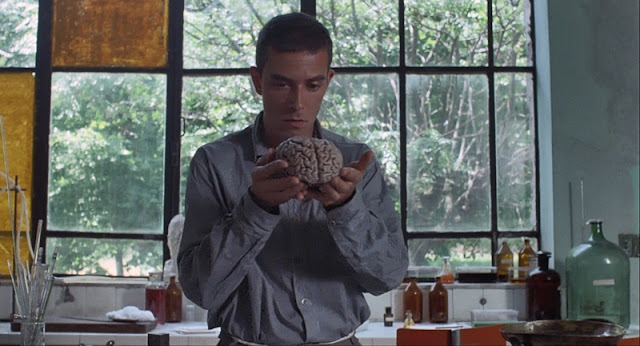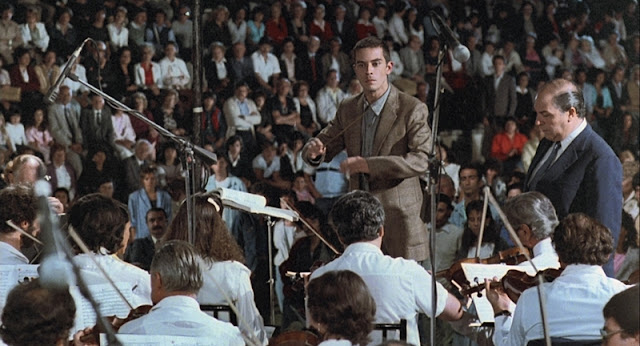(1986) Written and directed by Eliseo Subiela; Starring: Lorenzo Quinteros, Hugo Soto and Inés Vernengo; Available on Blu-ray and DVD
Rating ****½
“I’m more rational than you. I respond rationally to
stimulus. If someone suffers, I console him. If someone needs my help, I give
it. Why then, do you think I’m crazy? If someone looks at me, I respond. If
someone speaks, I listen. You have slowly gone mad by ignoring those stimuli,
simply by looking the other way. Someone is dying and you let him die. Someone
asks for your help and you look away. Someone is hungry and you squander what
you have. Someone is dying of sorrow and you lock him up so as not to see him.
Anybody who systematically behaves this way, who walks among them as if the
victims weren’t there, may dress well, may pay taxes, may go to Mass, but you
can’t deny he is sick. Your reality is terrifying, Doctor.” – Rantes (Hugo
Soto)
How do we separate the mentally ill from the sane, and is there such a thing as “normal?” Writer/director Eliseo Subiela raises these questions, and many others, with his nuanced parable Man Facing Southeast. Thematically, his film shares many aspects of One Flew Over the Cuckoo’s Nest, by way of The Man Who Fell to Earth but transcends those notable titles, largely thanks to Hugo Soto’s extraordinary, otherworldly performance as the enigmatic inpatient Rantes. Subiela based the character (and the film’s title) on an incident from his old neighborhood, where a strange man spent hour after hour standing stiff and motionless, while staring blankly into space, facing a southeasterly direction.* Man Facing Southeast was filmed in a real-life working institution, Borda Hospital,** located in Buenos Aires.
* Fun Fact #1: Subiela later learned that the man from his neighborhood was a former psychiatric patient who fell in love with one of the nurses. When he was discharged from the hospital, he would stand vigil, pointed towards her apartment window (until she eventually moved away).
** Not So Fun Fact: Prior to working on the film, Soto already
had an intimate knowledge of Borda Hospital, as it was the same institution
where his father had once been committed.
Dr. Julio Denis (Lorenzo Quinteros) is a psychiatrist at the end of his rope, burned out and devoid of passion, after seeing one patient too many swallowed up by the system. Likewise, his personal life is in tatters. Currently divorced, he only sees his kids intermittently. Denis spends his lonely hours at home playing his saxophone and watching home movies, ruminating over what was, and might have been. His life suddenly takes an unexpected turn when a new patient enters his life, seemingly from nowhere (during the latest headcount, there’s one extra individual among the patient roster). Rantes who claims to be an advanced form of holographic projection from outer space, stands in the hospital’s courtyard for hours, pointed southeast so he can (in his words) gather transmissions. Supposed extraterrestrial origins aside, Rantes exhibits a certain magnetism – many of the patients are drawn to him, finding comfort in his presence (even the doctor’s kids seem entranced). The new patient becomes a source of frustration for Dr. Denis, who’s convinced there must be some diagnosable form of mental illness, even though he can’t determine what it is. Based on this assumption, the doctor resigns himself to searching for holes in Rantes’ outwardly airtight argument. The third major player is Beatriz (Inés Vernengo), who visits Rantes at the hospital, and whom he refers to as “The Saint.” They share a connection and a past, although the details are sketchy. Dr. Denis thinks her presence could be the key to Rantes’ origin, as well as a possible cure, although her past proves to be as shadowy as Rantes.
* Fun Fact #2: Soto’s appearance as a Borda resident was
so convincing that the guards confused him for a real patient, and tried to
prevent him from leaving the premises.
Hugo Soto’s intense, measured portrayal of Rantes is the heart of Man Facing Southeast. He’s presented as a tragic, Christ-like figure, who cares for the downtrodden. Despite his keen observations, and empathetic behavior toward the marginalized patients the staff routinely ignore, he confides that he can’t feel. At times, we’re unsure who’s the doctor and who’s the patient. Rantes’ insightful questions cut to the quick (“Why do psychiatrists lean back when they listen to patients? Do they fear it’s contagious?”). When Dr. Denis tries to assure his patient of their equal ground, it prompts Rantes to ask, “…Why do you wear the uniform of the sane and I wear the uniform of the insane?” Rantes continually challenges the doctor, pushing him to the limit of his definition of mental illness. In an early scene, Rantes questions where the “magic” resides: What is the spark that creates prodigious intelligence, or love, or the impetus to create beautiful music? This parallels a later scene when the patient, working as an assistant in a pathology lab, pondering a dead lump of tissue that was once a living human brain, picking apart its creases in a futile attempt to unlock its secrets.
Music, in one form or another, plays a vital role throughout the film. Pedro Aznar’s* haunting, ethereal soundtrack adds greatly to the mystique that surrounds Rantes. The combination of conventional instruments (piano, flute, saxophone) and electronic sounds, evokes the chaotic, yet elegant labyrinth of his mind. Rantes’ spirited, flawless playing of the hospital church’s organ serves as a contrast to the emotional emptiness he feels inside. Music also provides the backdrop for a much-needed moment of levity in an otherwise somber, introspective film, as Beatriz, Rantes and Dr. Denis attend a concert in the park. In the middle of a performance of Beethoven’s 9th Symphony (aka: the appropriately named, “Ode to Joy”),** Rantes butts in, taking over for the conductor. The audience members dance and sway to the orchestra, under Rantes’ direction, while in the nearby hospital, his fellow patients parade around the facility, absorbed in a trance of ecstatic revelry. To the viewer, it implies that not only can he receive signals, but transmit them as well. Alas, to the hospital’s obstinate director, it’s the final straw.
* Fun Fact #3: Surprisingly, Aznar was not Subiela’s initial choice. Scoring of the film was already underway when the composer approached the director, entreating him to hear a tape of his version. One listen convinced Subiela that Aznar was the right guy for the job, which left the director with the unenviable task of firing the talented composer he originally hired.
** Fun Fact #4: The orchestra members refused to play the
piece again, so Subiela and his crew could get a shot from a different angle.
Instead, they were forced to edit in a tight shot of Rantes conducting, since
the orchestra had already left.
Denis is left with a dilemma: either Rantes* is insane or an alien. Because Rantes claims he’s from another planet, the psychiatrist concludes there must be something wrong with him. It’s impossible to accept the prospect that he’s an alien, because it would shake up everything that he believes to be true. To concede Rantes is not insane would only be an admission of his own insanity. Rantes tells Denis that the same thing is going on at psychiatric hospitals around the world, with similar patients to himself. At one point, the doctor almost indulges his curiosity, but pulls away at the last moment, because it’s easier to accept the former proposition. If it was mental illness and delusion, as Dr. Denis and his supervisor contended, what was Rantes’ crime and whom was he hurting? The short answer is that he was an embarrassment that needed to be suppressed. The director’s decision to ultimately drug Rantes (rationalizing that he could turn violent any moment) is more political than ethical. In the end, he’s more worried about saving face than the common good, and in his endeavors to maintain the status quo, he extinguishes the very thing that makes Rantes so special.
* Fun Fact #5: Cinematographer Ricardo DeAngelis wanted
to illustrate Rantes’ genius through the progression of light on his face. By
using a single light source, dangling just out of the frame the viewer could
see the reflection in actor Hugo Soto’s eyes. As the film progressed, DeAngelis
found ways to diffuse the light, to show the vibrancy gradually dissolving from
Rantes.
For the most part, Subiela sidesteps a definitive answer
about whether or not Rantes is human. We simply accept the reality of his
present situation. The film tips its hand slightly when we see a couple of
instances that appear to be telekinesis, but that only opens more questions. Was
this something that Rantes achieved, or was it only something he imagined? Does
it matter what he is? Ultimately, we are all responsible for Rantes’ eventual
fate. Society tends to value conformity, and pigeonholing everyone into neat
categories. If they don’t fit in, they’re sick. Rantes’ only crime was being
unlike everyone else. As a species, we abhor ambiguity. We fear and despise
anyone who defies categorization. It’s often much easier to go with the
simplest explanation, because it doesn’t challenge us. Besides the obvious
theological analogy, the story mirrors the fable of the Golden Goose. Rantes is
a gift to humanity that’s wasted – something too good and pure for this world. Man Facing Southeast will linger in your
mind and conscience, long after the final credits roll.
Sources for this review: (Fox-Lorber Blu-ray extras) Interview with Eliseo Subiela (2016), Interview with Hugo Soto (1993), Interview with Ricardo DeAngelis (2016)








A very insightful review, barry!
ReplyDeleteI've never heard of man facing Southeast, but it sounds like an intriguing and thought-provoking film.
Thanks so much, John! This movie is really special. I enjoyed discussing it.
DeleteThis looks really interesting! I've never heard of it before.
ReplyDeleteIt's a fascinating character study. Highly recommended! Thanks for stopping by. :)
Delete